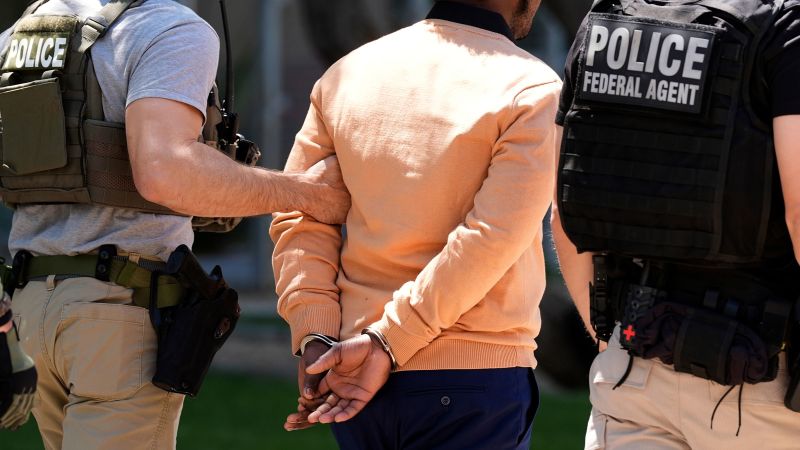The escalating situation surrounding immigrants and deportation strategies has captured significant attention across the United States. A critical concern is the recent practice of detaining migrants by immigration agents in courthouse hallways immediately after they have recently faced tribunals to present their cases. This alarming trend, which is turning immigration courts from venues of justice into areas of anxiety, has incited fear among migrants, their legal representatives, and advocacy groups. The situation represents a persistent challenge to the principles of due process that underpin the judicial system.
These courthouse arrests are not just coincidental; they form part of a broader strategy implemented during the Trump administration, designed to expedite arrests and intensify efforts to target migrants, including individuals who have only recently arrived in the U.S. Advocates and lawmakers are perturbed by this tactic, deeming it an unjust penalty for those attempting to comply with legal processes—an act termed by some as a betrayal of procedural fairness.
The Department of Homeland Security (DHS) has shifted its enforcement policy, rescinding long-standing guidance that previously curtailed immigration enforcement operations at or near courthouses, which were designated as “sensitive locations.” Officials in the Trump administration argue that previous restrictions hindered agents’ ability to apprehend purportedly dangerous individuals. Given this new reliance on “common sense,” agents are now empowered to carry out arrests within these judicial spaces.
Tricia McLaughlin, a DHS spokesperson, emphasized that law enforcement must be able to take action against undocumented immigrants labeled as criminal. However, internal documents reviewed by CNN reveal that the scope of the enforcement initiative is markedly wider, extending to migrants engaged in ongoing immigration proceedings who are not yet in detention—the non-detained docket. This development has evoked concern that the governance of these proceedings is being undermined by aggressive deportation strategies.
Internal documents outline a directive for Immigration and Customs Enforcement (ICE) agents to swiftly detain immigrants who have either received orders of removal or have had their cases dismissed. Particularly alarming is the directive that anyone residing in the U.S. for less than two years should be swiftly entered into deportation proceedings. This expansion of expedited removal, which President Trump initiated earlier in the year, positions migrants at increased risk of abrupt separation from the communities along with their safety and security.
Moreover, under these revised procedures, ICE agents have been authorized to collaborate closely with court personnel to pinpoint and detain migrants, typically executing these operations with minimal advance notice. A staff member from an immigration court in Hyattsville, Maryland, described chaotic scenarios when enforcement officials appear, escalating tension and uncertainty for those seeking justice within the system.
In contrast, Secretary Kristi Noem, via a senior DHS spokesperson’s statements, has described the current enforcement practices as a reversal of previous policies that allegedly allowed millions of undocumented migrants to roam freely within American neighborhoods. Critics, however, have labeled such approaches as reckless, warning that they fundamentally threaten due process, discourage migrants from attending immigration hearings, and compromise the overall viability of the immigration system.
Senator Ruben Gallego from Arizona articulated his concerns about the disruptive nature of these arrests, asserting that such tactics do not yield improved security, instead fostering apprehension among migrants and hampering the judiciary process effectively. Traditionally, arrests within or near courthouses have been recognized as exceptionally rare, executed only under special circumstances—a stark contrast to the current situation.
One poignant illustration of this alarming trend is the case of a young Venezuelan, Dylan, who was apprehended after his immigration court hearing in Manhattan. This mirrors similar incidents across various states, including Maryland and California, where individuals have been forcibly removed from the premises for simply complying with legal protocols. Immigration attorney Rachel Girod highlighted the case of a client detained after missing an ICE appointment, compounded by an administrative oversight regarding documentation—reflecting systemic inefficiencies that place individuals at risk.
In conclusion, the ramifications of the current enforcement strategies extend beyond individual cases. The chilling effect on migrant participation in legal proceedings risks eroding trust in the judicial system. As noted by leading experts in immigration law, individuals who harbor anxieties about potential ICE arrests may avoid appearing in court altogether, undermining their chance at protection. Without a serious reconsideration of these tactics, the situation surrounding immigration courts in the United States will continue to evolve into a space of fear rather than justice, markedly affecting the lives of many vulnerable individuals.











